|
FAQs about Fungiid Coral Predators, Pests
FAQs on Fungiid Disease:
Fungiid Disease 1, Fungiid Disease 2, Fungiid Disease 3, Fungiid Disease 4, Fungiid Health 5,
Fungiid Health 6, Fungiid Health 7, Fungiid Health
FAQs on Fungiid Disease by Category:
Diagnosing,
Environmental (Pollution/Poisoning,
Lighting...), Nutritional,
Social (Allelopathy),
Trauma,
Pathogenic (Infectious, Parasitic, Viral)
Treatments
Related Articles: Coral Pests and Disease; pests, predators,
diseases and conditions by Sara Mavinkurve, Fungiid Corals,
FAQs on Stony Coral Disease: Stony Coral Disease 1, Stony Coral Disease 2, Stony Coral Disease 3, Stony Coral Disease 4, Stony Coral Disease 5, Stony Coral Disease 6, Stony Coral Disease 7, Stony Coral Disease 8, Stony Coral Disease 9, Stony Coral Disease 10, Stony Coral Disease 11, Stony Coral Disease
12, Stony Coral Disease 13,
Stony Coral Disease 14,
Stony Coral Disease 15, Stony Coral
Disease ,
FAQs on Stony Coral Disease by Category: Diagnosing:
Environmental (Pollution/Poisoning, Lighting...),
Nutritional, Social (Allelopathy),
Trauma,
Pathogenic (Infectious, Parasitic, Viral)
Predatory/Pest,
Treatments
FAQs on Stony Coral Disease by Family: Acroporid Disease, Acroporid Disease 2, Acroporid Disease 3, Acroporid Disease 4..., Caryophyllid Disease, Caryophyllid Disease 2..., Elegance Coral Disease/Pests, Dendrophylliid Disease, Faviid Disease, Faviid Disease 2,
Mussid Disease, Mussid Health 2, Poritid Health, Trachyphylliid Disease, Trachyphyllia Disease 2,
FAQs on Stony Coral Disease by Type: Brown Jelly Disease, RTN,
|
Tissue recession from other causes... lack of nutrient,
improper lighting, supplements poured on...
Can look like other animal chewing.
|
|
Fungi<a> with strange parasite
12/9/11
Hello,
Thank you for taking my question.
<Welcome>
One of my recent additions is this lovely orange Fungia. It
looked very healthy at the LFS and continues to look healthy in
the tank. I dipped the coral in Lugos
<Lugol's; not my choice in iodide-ate soln's of
use>
solution prior to adding to the main tank. It is quite active
(moves around) and prefers to be snuggled into a large doughnut
coral (green).
<Mmm>
One evening I noticed what appeared to be an 8" long strand
of hair attached to the Fungia. Upon closer observation, there
were two 8" long "antennas".
Each "antenna" has numerous smaller hairs combing the
water column. Where the hairs are attached to the Fungia
is a small opaque blob. This blob can pull in the
"antenna" when disturbed or when it catches something
tiny.
During the day, the "antennas" are not visible. This
blob slowly moves under the surface of the coral daily.
I removed the coral, placed in shallow bowl and tried very
carefully to scrape the blob off. I did manage to get some slime,
but...? A few days back in the tank and the blob was visible and
moving.
This coral is about 3" round, tentacles extend, tissue puffs
up, it moves around and seems healthy other than this parasitic
hitch hiker on it. I just don't want the blob to make more
blobs or endanger the Fungia.
<Understood>
Today, I finally got a good picture of it. In this picture the
blob looks like a tiny star fish, but it is not a star fish and
seems to be under the tissue. The blob is becoming more visible
than it was a month ago.
Any advice on what it is or how I can get rid of it?
<Can't make this organism out in your pic... even w/
enlargement, optimization. IF you have a larger, better-resolved
image, please send it along. This may be (my first guess) a
Hydrozoan of some sort... a stinging hydroid. Whatever it is, the
treatments applied by folks for Aiptasia/Glass Anemones are
avenues to try. Yes; may kill the immediate area around... but
this Fungia should be able to regenerate this in time>
Background: Tank is 150 gallon reef, 30 gallon sump, 15 gallon
refugium, AquaC skimmer, 3 power heads, 1 year old (much
livestock/live rock transferred from my 3 year old tank), 200
pounds live rock, various hermits, 9 healthy fish, 3 clams,
brittle stars, various corals, 81 degrees F, Orphek LEDs, 10%
water changes weekly, no current algae problems, I feed 8
different types of foods (frozen, flake, pellet, live, freeze
dried), all water parameters good... I could go into more detail,
but this question is regarding the parasite.
<Ahh!>
Wet Web Media has been so helpful to me. Thank you. I can try
taking better photos if needed.
Sincerely,
Wendy
<Please do. Bob Fenner>
|
|
 Full size pic Full size pic
|
|
Happy Fungia Unraveling Fast: Mysterious Tissue
Transfer Matter, or Attack of the Benthic Ctenophores?
10/30/11
A "Hola!" Bob and Crew!
<Howdy Alex!>
I wouldn't write if I could find anything conclusive online,
and so far I have not found much...
I am concerned about the smaller of my two Fungia specimens. It
has, over the last two or three days, developed several (2-5
visible at a time) jellyfish-like tentacles that drift and trail
string-like from the edges of the polyp.
<I see these in your excellent pix>
All the typical tentacles are extended like normal, and the
Fungia still seems content most of the time: its polyp is almost
always inflated, except when it exhales... The thing is, these
stringier tentacles don't resemble any coeloplana I was able
to look up (only one image I saw involved a Fungiid anyway);
everything I saw online had more feathery or spider-webby
strands.
<These look mysteriously like some types of stinging Hydroids
I've seen on various Scleractinians over the years...
>
The ones on my coral have one smooth strand paired with a much
more rippled strand, connected by a transparent strip of
tissue.
In the more close-up picture with the red-bordered strip, the
string's base is at the left-hand side of the strip, and it
extends across most of the disc to the right. I can't see any
distinct connection so it is hard to tell
if it's part of the coral polyp or if it's a distinct
creature all its own.
The longer string visible in the zoomed-out image is only partly
in the frame in the close-up, since I was trying to focus on the
important aspects of the images. The zoomed-out image is there to
show the character of the string...
Generally, since the coral seems alright overall I wouldn't
be worried, but a few single blades of the razor brain's
skeleton are exposed, conveniently located about where the
milky-white wisps seem to emanate from. Is my Fungia
unraveling?
<I think it's being stung... would spot treat w/ an
Aiptasia chemical treatment... to wipe out the Hydropolyp>
As you can see in the attached pictures, when the polyp is fully
inflated you essentially can't even see the exposed bone
blades, but in the shot I took after the plate had expelled most
of its water and waste, the blades within the two circled spots
are obviously bare (there are actually two exposed in the area on
the right). I guess strong currents could cause those little rips
in the polyp to happen, but I don't think that's really
the issue in this case, nor do I think my fish are pestering it.
I'm pretty sure my Cirrhilabrus melanurus acts as more of a
steward to the Fungia, and none of the other fish really get
that close to them. I did see my Sailfin tang "test"
one of these new trailing strings, but he did not rip it off, and
it did not retract (hard to be certain, but I don't think
these strands are very reactive; if they are some sort of benthic
ctenophore, possibly they are parasites rather than
symbionts...?). He didn't seem too interested in the strings
after that though, so maybe they did sting him. Apologies if
there's some obvious FAQ about this that I missed... Nothing
I read seemed to really describe what I've got going on and
most times the experts seem to stress the harmlessness of the
situation, but I'd prefer to not have one of my favorite
corals skinned alive if there's a way to prevent it so
I'll err on the side of "too cautious" and let
myself email you guys.
<DO peruse here: http://wetwebmedia.com/HydrozIDF8.htm
I feed the tank well, using a blend I made of brine and Mysis
shrimp, Nori and macroalgae (sometimes solo, for the tangs...),
squid, Spirulina, silversides, raw whole table shrimp, garlic,
and pure water, all pulsed into minced mash in an old cracked
(fish only) Cuisinart, then frozen into thin chips. I believe the
corals all filter in their fair share, but I still spot feed
occasionally just in case. If you remember our previous
correspondence, you'll be glad to know that I've since
upgraded my lighting to 432W of T5 (3 daylight, 1 purple, 4
actinic), which combined with the morning sun (the tank is in an
East-facing window) I think makes for a decently-lit sand floor
(I have noticed a positive response in everything in the tank
except one minor Cyano outbreak that occurred right after I added
the lights).
And though I have moved the razor brains a few times when
adjusting rocks or adding cupfuls of live sand to their area of
the tank, as far as I know there have been no severe traumas to
either one since placing them in the tank, and my water
parameters are good: NO3 < 30ppm, PO4 ~ 0.25-0.5ppm, dKH ~
9-10, Calcium ~ 420-440ppm, and Magnesium was pretty high
(~1550ppm) last time I had the LFS test it (they use Salifert for
Mg). Admittedly, the alkalinity has been hard for me to really
stabilize more than about 10 +/-1 degrees KH, and I know Fungiids
are picky about carbonate hardness but it's not been higher
than 11 degrees since before I added the Fungia spp (for well
over a month now), and both of them are fleshy and vibrant almost
always. Besides that, I am pretty sure both my Fungia are
aquacultured (sustainable and tough), though I can only be 100%
certain of that for the big one, which was born in a local
friend's tank (and which is not the subject of this
particular plea, though it is beautiful, if you care to see:
http://a3.sphotos.ak.fbcdn.net/hphotos-ak-ash4/384413_10100593589104572_10104357_56909006_397996915_n.jpg
).
A toast to your time, tenacity, and tolerance. Yia Sas!
PLAH!
Alex:D
<Thank you for sharing as always Alex. Do relate your further
experiences here. BobF>
|
|
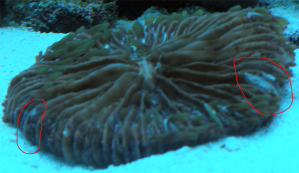 
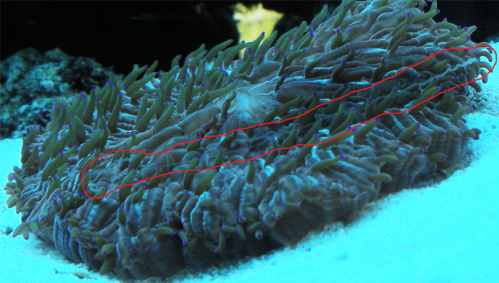
|
|
Re: Happy Fungia Unraveling Fast: Mysterious Tissue
Transfer Matter, or Attack of the Benthic Ctenophores?
10/31/11
Hi Bob! Thanks as always for your quick reply...
<Welcome Alex>
I had a feeling that I was missing a key search term when I was
trying to research this. After reading up a bit on hydroids, I
think you're likely right, though I still haven't found
any pictures of anything similar. Do you think what I'm
dealing with is juvenile (i.e., yet to turn Medusoid), or would
you guess these are already in an adult stage?
<Likely the latter>
I'd prefer to dip just the coral versus treat the whole tank
if possible...
<Then I would do this soon... rather than risk the polyp
spreading (they can/do!)>
I've had the Fungia for a little over a month, and this is
the first time I've seen hydroids so I suspect they came
already attached to it since there aren't any elsewhere in
the tank.
<Yes; highly likely>
Is that unlikely based on the time it took for them to be
evident? I just don't want to unnecessarily over-medicate...
Do you think it will be OK to treat the Fungia on its own so as
not to massacre my tank's existing worm population?
<I do>
Or possibly, when you say "spot-treat," you mean
don't even treat the whole coral but just try and zap the
individual hydroids themselves?
<Yes; this last>
Interestingly enough, I believe this morning the Fungia was
actually EATING one of the hydroid strands, but there were still
two small ones (not fully extended) visible at the edges. I'm
curious how it will look when I get home from work. If the Fungia
did eat any hydroids, would that be a good thing or is it just
going to be stung from the inside now as well?
<As long as they're not too numerous; too
stinging...>
Whether they came in with the Fungia or not, I suspect that the
slightly-elevated nutrient content is helping the hydroids
thrive. For the last two months until about five days ago, my
nitrate levels were around 20ppm, but just recently they jumped
to maybe 25 or 30ppm. I took your suggestion to add a Sock-It to
my sump (had to modify the overflow outlet but it has been worth
it...) and I change and rinse the sock every week (actually got
two extra socks to allow them to dry completely between uses),
but I have noticed lately that the foam level in my EV-180 has
been fluctuating a lot and I'm not sure why.
<Foods/feeding, diurnal rhythms...>
The foam is fine most of the time
but falls to the top of the box seemingly at random and then
re-stacks over the course of 10-15 minutes, so that a lot of
gunky skimmate collects in the foam column as well as the top cup
(and subsequently gets slowly re-added to the water, methinks),
and I suspect this may be at least partly the cause of my
elevated nitrates and phosphates, but I don't know the cause
of the fluctuations themselves. The sump chamber which the
fractionator's pump sits in has a constant water level, even
with the rest of the pumps turned off. I did add some pipe to the
skimmer's return line (post gate-valve) because the skimmer
itself is no longer in the sump, but if that's the issue it
took over two months to start expressing itself. I am emailing
Jason Kim with pictures and more details, so hopefully he can
help me stabilize my foam levels, but if anything I've told
you rings bells in your brain feel free to offer input.
<Just the usual tinnitus unfortunately>
I will forward his reply so you can
post it on WWM. In the meantime, a fresh bag of GFO and activated
carbon into the sump, and lots of crossed fingers that I can save
this befouled Fungia...
I #$&^@*% love you guys. Donations coming soon (but first I
must pay my utilities... you understand...)
PLAH!
Alex:D
<I do. B>
|
|
Plate Coral Problems 02/15/09 Hello to all. I
haven't had to write you for quite a while as all has been
going well in my system. Parameters: 125 gallon mixed Sps and
LPSs, SG= 1.023, DKH= 10, Nitrate = 1 ppm, Phosphate = 0,
Ammonia
= 0, Temp = 74 degrees F Water change = 30 - 40 gallons bi
weekly, Filtering = 2 Eheim wet dry filters + 4 oscillating power
heads No skimming and no UV <74F, SG of 1.023... wet/dry
filtration and no skimming?! ...man, you're killing me! >
plenum under 4" sand bed 150 lbs live rock covered in
coralline algae and sponge Many little critters and corals along
with main stock of LPS (Even visible copepods in the sand bed) I
have had this short tentacled plate coral for over a year.
Recently my blood shrimp pair set up house in reach of the plate
and lo and behold, the instant the plate coral catches some food,
the shrimp dive on him and steel it. I created a cage so that I
could feed it in peace but, I have noticed damage to the tissue
around its "mouth". My assumption is that the shrimp
are still stealing even after the coral has actually consumed the
food. This is supported by me catching one with its pincer half
way down the feeding orifice. The question is this, what can I do
about the tissue damage? There is already algae growth on the
exposed skeleton. The coral is still feeding and otherwise
appears happy but I am concerned about the tissue damage since it
does not appear to be regenerating and is not likely to grow over
the algae. I actually read an article about fragging these corals
and was wondering if I should try it as a last ditch effort to
save it. If I can successfully frag it, I can move the pieces to
the other side of the tank away from the shrimp. <Well, when a
Fungia loses its mouth, it's a challenge to get it to
recover, but it's certainly not impossible. It just needs a
lot of TLC... in the long term though, sounds like you might have
to move those shrimp. Cheers, Sara M.>
Re: Plate Coral Problems 02/16/09
I thought I would send on some pictures of the plate I want to
save. I also include a picture of a "rescue" brain that
although the main portion of the animal failed, appears to be
doing something similar to the Fungia described in your articles
by producing a "daughter" coral.
<I think you're referring to when Fungia produce
anthocauli. What's going on with your rescue Mussid might
look similar, but it's not the same deal.
What happens sometimes with the open brain corals... when they
die off, but there's a glob or lump of healthy tissue left...
they can regrow. But they don't regrow into the dead
skeleton. They just start growing a whole new skeleton. So
it's not so much a true "anthocauli" because the
"offspring" is not really an offspring at all, but the
parent colony regenerating the small bit of it that was left
after most of it died. With the Fungia and anthocauli, the whole
parent colony dies off, but springs these offspring.
There are some reports though, that Fungia might produce
anthocauli even when they're not dying. In any case, it's
a different scenario than when, rather, you just have a
regenerating bit of coral. Do you understand what I'm
saying/describing?>
I have decided to leave that one alone and see what happens. The
picture of the plate shows where the algae has begun growing on
the original damage by the mouth. This whole process is now
months old. Just wondering if I should
continue to leave it alone.
<I would just leave it alone... unless you can very easily
pull the algae off. I've had this happen to me with Fungia at
least twice before. They can come back if you just be careful
with them (keep your water quality high... good feeding,
lighting, water movement, etc.).
Cheers,
Sara M.>
|
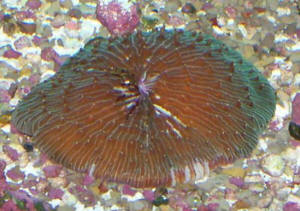 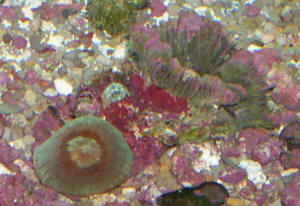 |
|
Re: Plate Coral Problems
02/19/09
Hi Sara and thanks again for the advice on the plate coral. As
for lower temp and salinity, this is not the only method I use
just an added stabilizer. The two spray bars and four oscillating
powerheads pretty much ensure rapid turn over of the water in the
tank along with providing surface turbidity. Since it is also
known that lower salinity and temperature increases the amount of
dissolved oxygen that water can hold, I keep it at the lower ends
of the acceptable parameters.
<Ok, but... why do you assume that having maximum dissolved
oxygen is more important than having ideal temperature and
salinity? Well, in any case, it's your system.>
I realize with a larger volume of water I should probably not
worry about a few degrees of temp or .002 increase in SG but, it
does help me maintain peace of mind. Thanks again for your rapid
responses and I will continue to
follow your postings. Keep up the good work. ;)
<Same to you, thanks.>
Sincerely
Beth Beardsley
<Cheers,
Sara M.>
|
|
Sick Fungia -02/25/08 Hi. I hope you can help me. <me
too> I picked up a small orange plate coral (Fungia) about
three days ago. I drip acclimated as I normally do any coral I
get. The first night, he seemed as happy as a clam. Mouth was
visible and his tiny little tentacles were extended. Sometime in
the night, something horrible happened. Something in my tank
seems to have snacked on him. <Hmm... no, looks like tissue
recession to me.> It is missing tissue that was fine when the
lights went off. My GUESS is a peppermint shrimp. <not
likely> I also have some blue leg hermits and snails. As far
as fish, I only have a couple bar gobies, a canary wrasse and a
Firefish. After I found him the next day, I quarantined it in the
tank so nothing can get to it. It's now in a slotted breeder
box (with sand in the bottom) held in the middle of the tank by a
magnet scraper (feel free to laugh, but its working). It's
little tentacles still extend, except for the part where the
flesh is injured. I have given it a small piece of Mysis to see
if it would still react to it, and it grabbed hold and pulled it
slowly towards its mouth. However, his mouth is not visible. By
that I mean, it's wide open. Maybe looking at a picture of it
would help (see attached jpeg). That is actually a piece of Mysis
he has in the 'mouth' (the black dot is a Mysis eye I
believe). <It looks like, maybe, the mouth is just very, very
retracted.> Should I keep spot feeding this guy every couple
days to see if he comes back around? <Yes> Do you think
there is a snowballs chance he'll make it?? <Oh yeah, sure
there is. Though these corals are not necessarily easy to keep,
they are capable of some remarkable recoveries. And your coral is
not in all that bad a shape. It's struggling for sure, but
it's far from doomed.> (in the photo, the missing tissue
is towards the edge of the top left) :-( -wuf <Good luck, Sara
M.>
Re: sick Fungia... shrimp bothering
3/2/08 Thank you for your response on my stressed out/damaged
Fungia. However, after several days of it recouping in a
segregated box, I have to respectfully disagree with your
conclusion. Here is why (if you are interested): After keeping
the plate coral in a separate container in the tank and spot
feeding it, it came back to it's 'normal self'. It
was polyping out fully and the mouth was no longer gaping. Not 2
hours after I placed it back in the bottom of the tank, I found
TWO peppermint shrimp sitting on top of it picking at it. Of
course, all tentacles were pulled back in and the mouth was
starting to gape. I immediately pulled it out and put it back
into it's separate area. I also found the peppermints
harassing my tongue coral. That being said, I believe that
peppermints can be more of a nuisance to these LPS's than
some would like to believe. <Hmmm, I must not have been very
articulate with what I was saying before. I didn't mean to
say that these shrimp can't be a nuisance to these corals.
Rather, I mean to say that it's unlikely that they are
actually *eating* the coral. However, there are plenty of other
ways they can be a nuisance. They can steal food (even from out
of the mouths of the corals). They might also be picking at the
coral's mucus. Even just their "standing" on the
coral can cause the coral to retract and be stressed (as
you've seen).> Just my 2 cents...... <Thank you for the
update. Great to hear your coral is doing better! Best,
Sara M.>
|
|
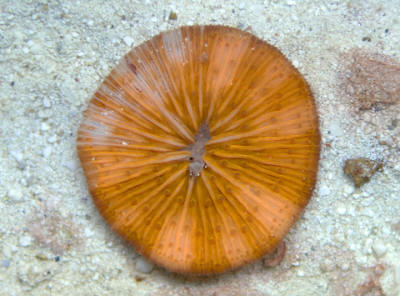
|
| Crazy Worm? -- 02/27/07 I just got home to my
poor stressed tank and see something very strange on my clump of
dish coral. Two or three corals have developed close
together and it looks like some type of segmented worm going from
one to the other. Or could they be transferring
material? I am not sure if I should get it with tweezers
or not. I am sending a photo along. Thanks, Cathy
<<Well Cathy I can't really make anything out from the
photo, but this doesn't look like a worm to me...it appears
more to be mucus/excrement...and likely nothing to be concerned
about. Regards, EricR>> |
|
Re: Crazy Worm? -- 02/28/07 Thanks again Eric.
<<Hi Cathy!...quite welcome>> I just wanted to follow
up. In fact, it was a brown segmented worm.
<<Ah, thank you for this...I did not get that from the
photo>> Have you ever heard of this before.
<<Mmm...many, many, MANY species of worms about (in excess
of 10,000 I do believe). Do you have any (missing?)
fan/tube worms? Possibly one of these exited its
parchment tube and was actually being consumed by the coral
rather than the other way around>> It was as if it was
going into the mouth of my dish coral. <<Yes...did see
this>> I did yank it out and had it move around
awhile. I could not identify it. <<Too bad you
didn't take/send a close-up pic>> Seemed more like an
earthworm than bristle worm. <<From what I could discern,
yes, would agree it was not a bristle worm>> Thanks again
for all your advice. Cathy
<<Always happy to try to
assist. EricR>>
|
|
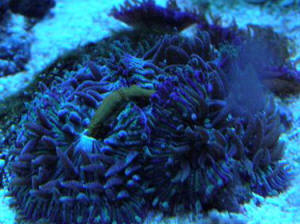
|
|
|

